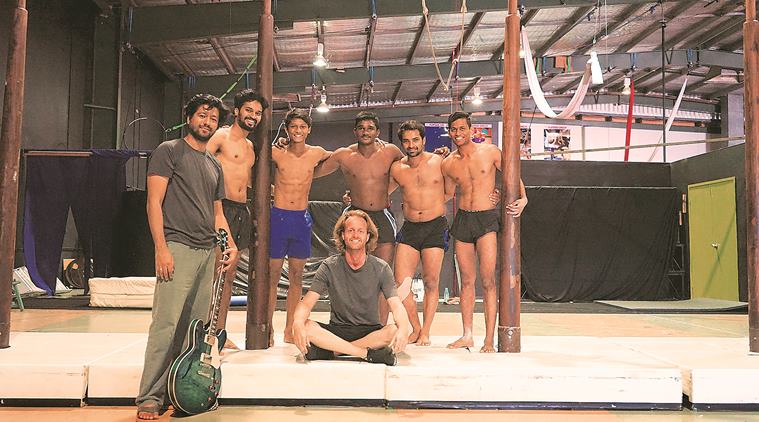 MallakhambIndia in a previous performance
MallakhambIndia in a previous performance
Rajesh Mudki is a long way from his home in Santa Cruz (W), but for 33-year-old co-founder of MallakhambIndia, there’s no place he’d rather be than on top of a well-oiled sheesham pole. Last morning, while members of the Indian contingent at the 2018 Commonwealth Games (CWG) battled it out inside stadiums and arenas, Mudki and his fellow Mallakhamb artistes took the stage at Festival 2018, the cultural festival of the CWG in Gold Coast, Queensland, Australia. In a 30-minute performance, the five-member troupe from Mumbai displayed an incredible sense of balance, dexterity and discipline that left viewers in awe.
A combination of wrestling, gymnastics and aerial yoga, Mallakhamb is one of the oldest Indian sports, and though the exact era of its origins is yet to established, the tradition is believed to date back to the time of the Maurya dynasty. Originally devised as an exercise for wrestlers and warriors, over the centuries, Mallakhamb has evolved from being a traditional sport to being viewed as a performance art. “For the past nine years, I have been travelling globally to perform Mallakhamb at various shows and reality TV talent programmes,” says Mudki. Bringing him and his fellow performers — Rajesh Amrale (33), Atharva Angre (16), Jarard Quardras (17), and Akshay Taral (22) — to the cultural festival of this year’s Commonwealth Games is Australian director, Benjamin Knapton, who works across theatre, contemporary circus and film.
 MallakhambIndia with director Benjamin Knapton (seated) and songwriter and producer Donn Bhat
MallakhambIndia with director Benjamin Knapton (seated) and songwriter and producer Donn Bhat
“In 2016, I worked with some artistes from Mallakhambindia on a show called ‘One Beautiful Thing’, presented by AsiaTOPA Festival. I loved Mallakhamb so much, I returned to Mumbai to work with them again last year,” says Knapton, over email. Soon, Yaron Lifschitz, director of the CWG’s culture fest, invited him to direct a new performance that would showcase Mallakhamb at the Games. “Mallakhamb is normally presented in 90-second sections only, as a competition. For this show, I wanted to create a 30-minute performance where Mallakhamb and music would feature the whole time. I wanted to demonstrate the sport but also create a work of poetic beauty that allowed the bodies to speak strongly to an audience. What can we learn about our world by encountering an ancient sport like Mallakhamb,” says Knapton.
“Traditionally, we don’t use music to perform Mallakhamb,” says Mudki, “When we started MallakhambIndia in 2006, we began adding music to lend an entertainment element to the performance. We usually use instrumental music, and authentic Indian styles which includes tabla, dhol, and sitar,” he says. But for CWG 2018, Knapton decided to go in a different direction, and roped in Mumbai-based electro-rock songwriter and producer, Donn Bhat, to create a soundscape that would accompany the routines executed by the Mallakhamb performers. “His work is both cinematic and cutting edge. He has a unique ability to create music that can have a message, and also take the audience on a sonic journey,” says Knapton.
Bhat, 35, has composed eight pieces which he says are strictly steering clear of high-octane dhol music that is usually associated with Indian performances. “When Ben and I met to discuss the sounds he heard during the MallakhambIndia practice sessions in Juhu, he mentioned street sounds, azaan, chaiwallahs, airplanes flying overhead. It took me a bit to understand that along with music, it was also a lot of sound design that could really add character to the score,” he says. Using the susurrus of waves as an entry point to the soundtrack, Bhat mixed, manipulated and morphed rough folk recordings, non-musical sounds, including his ceiling fan, and found sounds from the streets to create an arrangement that would tell the story of Mallakhamb.“The performance spaces at CWG 2018 are all outdoors by the ocean. We play the Roundabout Stage for three days, and then the main stage on the final day, April 11,” he says. For one of the shows, MallakhambIndia and Bhat will be joined by British-Indian singer, Susheela Raman.
For Knapton, the show is much more than just a performance of an incredible artform. “Travelling together both in Mumbai and Australia, the creative team have been consistently influenced by our similarities and differences. How do we understand one another if we don’t negotiate with each other? How do we understand one another if we don’t deliberate together? How do we understand one another if we don’t make something new together? These questions have been a very practical process of our collaboration and have fed our artistic creation,” he says.
As for Mudki, there’s no time to rest. Once he returns from CWG 2018, he is off to join the team at Cirque du Soleil, the Canadian powerhouse entertainment company that produces some of the biggest theatrical shows in the world. “Starting on April 30, Rajesh Amrale and I will perform Mallakhamb for the first time in a Cirque du Soleil show; we are the only artistes from India who have been invited to join them,” he says.